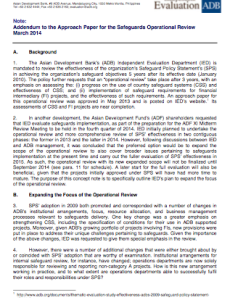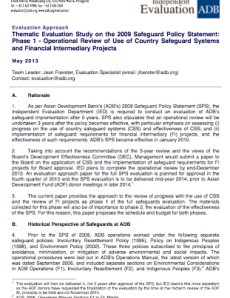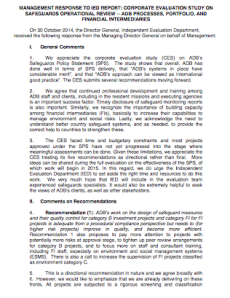
Safeguards Operational Review: ADB Processes, Portfolio, Country Systems, and Financial Intermediaries
The Asian Development Bank (ADB) and other multilateral development banks (MDBs) use safeguard measures as conditions of their loans to shield against collateral damage to communities and the environment that projects can cause, notably in transport, energy, and urban services. Without such shields, roads can hurt habitats, dams displace communities, and urban renewal damage livelihoods.
The crucial rationale for safeguards is that public and private investors do not automatically and voluntarily mitigate damages that spill over from their actions. In redressing these collateral injuries, sound economics and ADB's experience make the case clear for MDBs to have safeguard regulations and compliance on the one side, and improvements in the efficiency and effectiveness of their application on the other.
When ADB consolidated its safeguard policies into the Safeguard Policy Statement (SPS) in 2009, it asked Independent Evaluation to carry out an operational review after 3 years. This was intended to be limited in its scope, but has gained in importance, given two recent shake-ups in development banking—a review of the World Bank Group's safeguards policy, and the arrival of two new lenders, the Asian Infrastructure Investment Bank, and a BRICS bank—which could affect the strength of the shields.
The operational review used various data sources and triangulated its findings with interviews with ADB project staff and safeguard specialists. Its conclusions indicate that a proper system for avoiding or mitigating the environmental and social risks of ADB supported projects is in place, and that there have been more careful procedures and also needed increases in staffing since 2010, which help ADB and countries in avoiding major environmental and social problems.
Appropriately, the SPS covered additional investment modalities and additional environmental and occupational health and safety areas. With important improvements in efficiency and effectiveness, the safeguard system at ADB would be the type that can be trusted to care for social and environmental outcomes in countries.
This review contains proposals for improvements. First, ADB needs to pay more attention to the design as well as implementation and supervision of safeguard measures for all risky projects—not only those with high risks but also with substantial risks. Second, follow up is needed to support the use of country safeguard systems if and when they can move to full equivalence with ADB standards; accordingly, developing country capacity is in order. Third, ADB should provide better reports on the due diligence for financial intermediary projects, do more field monitoring, and more generally, third party verification.
A difficult underlying issue across the board is how greater due diligence for safeguards can be squared with ADB's intention to keep the time for project preparation relatively short. Actions planned by ADB for assigning safeguard staff to more resident missions, and making realistic project implementation schedules using readiness filters, can help.
The next, fuller evaluation of safeguards in 2015 will have a greater focus on field verification of safeguard results. The additional evidence on impacts from that assessment would lie on the path for strengthening safeguards in their key dimensions—scope, coverage and categories; design, implementation and supervision; country systems, equivalence and capacity; monitoring, and third party verification.




